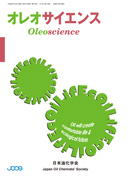
- |<
- <
- 1
- >
- >|
-
Hideki SETO2016Volume 16Issue 10 Pages 463-471
Published: 2016
Released on J-STAGE: February 01, 2019
JOURNAL FREE ACCESSNeutron Scattering is a powerful tool to investigate structure and dynamics of soft condensed matter including colloids, because it has an advantage to highlight specific parts of materials by substituting deuterated hydrogen. Here experimental results of water-in-oil microemulsion composed of water, oil and surfactant as a typical example.
View full abstractDownload PDF (855K) -
Mitsuhiro HIRAI2016Volume 16Issue 10 Pages 473-486
Published: 2016
Released on J-STAGE: February 01, 2019
JOURNAL FREE ACCESSCurrently, the use of synchrotron radiation X-ray is a quite important and general approach not only for the basic research in the field of life and material science, but also for various in dustrial applications, such as drug designs and new-materials developments. For this reason, in Eu rope and the United States, as well in Asia, Oceania, and South America, the constructions of new large-facilities of synchrotron radiation have been continued. On the other hand, despite usefulness of neutron in material research as similar as synchrotron radiation X-ray, the use of neutron is limited since it requires a dedicated reactor or large-accelerator. On this point, Japan realizes favorable environment for material research because we can use the synchrotron radiation large-facilities such as SPring-8 and KEK-PF, and the research reactor JRR-3M and the pulsed neutron source (J-PARC MLF) creating the world’s highest beam-flux intensity. Further, the neutron is suitable for observing the structure and dynamics of biological material and soft matter containing amounts of hydrogen atoms that are hard to detect for synchrotron radiation X-ray. By the combination of both, we can obtain a unique structural information. In this report, I will introduce about some application examples on the biomembrane structure and the interaction between biomembrane and protein by using neutron and synchrotron radiation X-ray complementary.
View full abstractDownload PDF (1566K) -
Hiroki IWASE2016Volume 16Issue 10 Pages 487-492
Published: 2016
Released on J-STAGE: February 01, 2019
JOURNAL FREE ACCESSI introduce specifications and research activities on the time-of-flight (TOF) small and wide angle neutron scattering instrument (TAIKAN) installed on the Material and Life Science Experimental Facility (MLF) in the J-PARC, Tokai, Ibaraki, Japan. By using white neutrons in the wavelength range of 0.5 < λ < 7.8 Å based on TOF method, and four large area detector banks, the TAIKAN can cover simultaneously cover a wide Q range from 5×10–3 to 18 Å–1. Recently, we installed the ultra-small angle detector consisting of a cross-wired position sensitive photomultiplier tube combined with a ZnS/6LiF scintillator, and magnetic neutron lenses in order to extend the accessible low-Q limit. Several sample environments, such as a stretching cell, a superconducting magnet, a vapor sorption apparatus and a rheometer, have been constructed. As recent research activities, complementary SANS and SAXS studies of spherical micellar solutions are introduced. I also show the first result of Rheo-SANS experiments on the TAIKAN carried out on wormlike micellar solutions.
View full abstractDownload PDF (920K)
- |<
- <
- 1
- >
- >|